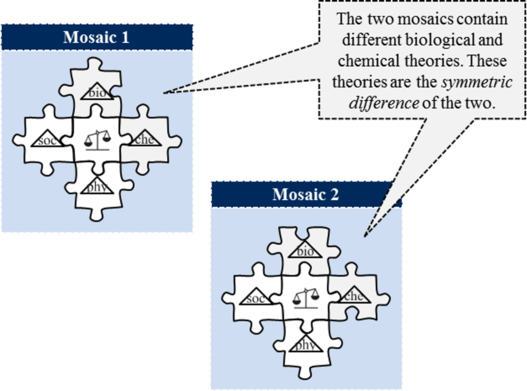Mosaic Merge (Barseghyan-2015)
This is a definition of Mosaic Merge that states "A scientific change where two mosaics turn into one united mosaic."
This definition of Mosaic Merge was formulated by Hakob Barseghyan in 2015.1 It is currently accepted by Scientonomy community as the best available definition of the term.
Contents
Scientonomic History
Acceptance Record
| Community | Accepted From | Acceptance Indicators | Still Accepted | Accepted Until | Rejection Indicators |
|---|---|---|---|---|---|
| Scientonomy | 1 January 2016 | The definition became de facto accepted by the community at that time together with the whole theory of scientific change. | Yes |
Question Answered
Mosaic Merge (Barseghyan-2015) is an attempt to answer the following question: What is mosaic merge? How should it be defined?
See Mosaic Merge for more details.
Description
According to Barseghyan (2015), for mosaics to merge, that is, to "turn into one united mosaic," there must first exist (at least) two distinct mosaics. This necessarily means that there are elements which are present in one mosaic but absent in the other. "To use the language of set theory," Barseghyan writes, "these are the elements that constitute the so-called symmetric difference of two mosaics [...] Therefore, in order for the two mosaics to merge into one, these elements should either be rejected in both or accepted in both, so that the differences between the two are resolved".1p. 214
The gist of this definition can be illustrated by the following examples.
Mosaic Merge: mid 18th-century Dutch and Swedish mosaics
According to Barseghyan (2015), "the acceptance of the Newtonian theory led to a mosaic merge". Specifically, "it led to the merging of the Dutch and Swedish mosaics into a unified mosaic with the Newtonian natural philosophy and Protestant theology":1p. 215
It is well known that, on most of the Continent, the Newtonian theory (together with its 18th century modifications) became accepted only after the confirmation of one of its novel predictions. Although, according to popular narratives, the theory was confirmed only in 1758 after the return of Halley’s comet, it is safe to say that it was actually confirmed in the period between 1735 and 1740 during the observations of the Earth’s shape.
The story goes like this. In 1735, the accepted natural philosophy on most of the continent was the updated version of the Cartesian theory, which assumed that the Earth must be slightly elongated at the poles. The assumption that the Earth is a pro-late spheroid was also in accord with the results of the geodesic measurements of Giovanni Domenico Cassini and his son Jacques Cassini announced in 1718. Initially, however, the Earth’s prolateness wasn’t a consequence of the Cartesian natural philosophy. When Jacques Cassini announced his results, the accepted theory of gravity was a version of Descartes’s vortex theory modified by Huygens. According to Huygens’s theory, the equilibrium state of any homogenous fluid mass, subject to aethereal pressure, was not prolate but oblate spheroid. Thus, in 1718, the prolateness of the Earth announced by Cassini was an anomaly for the accepted Cartesian natural philosophy. In the period between 1720 and 1734 several attempts were made to reconcile the results of Cassinis’ measurements with the accepted theory of Huygens. There is no unanimity among the historians as to which reconciliation became actually accepted. On Barseghyan's reckoning, it was the very first reconciliation provided by Mairan in 1720, which absorbed the anomaly by stipulating the Earth’s primitive prolateness.2p. 212 In any case, we know for sure that by 1735 the prolate-spheroid Earth was already part of the accepted version of the Cartesian natural philosophy. As for the Newtonian theory (which was a contender at that time), it was predicting that the Earth is slightly flattened at the poles, i.e. that the Earth is an oblate spheroid.
In order to end the controversy, the French Académie des Sciences organized two expeditions to Peru (1735-1740) and to Lapland (1736-1737). The latter expedition led by Maupertuis who was accompanied, among others, by Swedish astronomer Anders Celsius, returned to Paris in the summer of 1737. Its results showed that the prediction of Newton’s theory was correct.3 This conclusion was also confirmed by Jacques Cassini’s son César-François Cassini de Thury who re-measured the Paris-Perpignan meridian in 1740.2p. 234 As a result, the Newtonian theory replaced the Cartesian theory in all the mosaics where the latter was accepted. In particular, this resulted in the merging of all protestant mosaics where the Newtonian theory became accepted.1pp. 215-216
Reasons
No reasons are indicated for this definition.
If a reason supporting this definition is missing, please add it here.
Questions About This Definition
There are no higher-order questions concerning this definition.
If a question about this definition is missing, please add it here.

